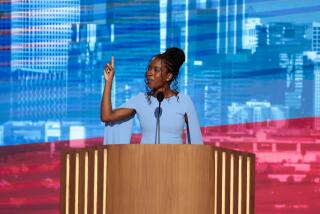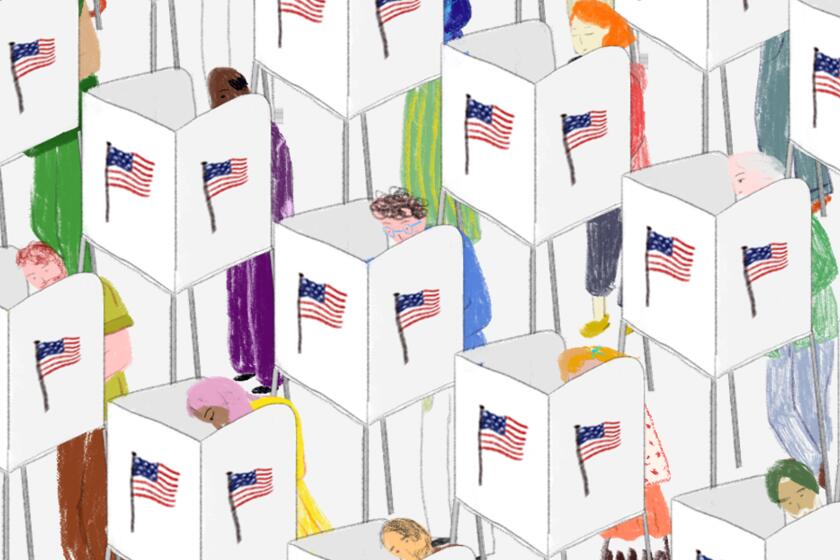Op-Ed: How our greatest poets found America riding public transportation

How many of us grow rapturous in the presence of an American bus? The number, I’d guess, is relatively small. Hulking metal loaves of the urban landscape, buses do not, when rattling past, draw voices down to a reverential hush.
This collective disdain, born of class warfare and the American obsession with cars, does buses a disservice. They’re democratic institutions, sightseeing stalwarts, and the delivery system for poetry — both found and made. To ride one among neighbors, the stamp of your municipality affixed to its hide, is to bind the communal and the commuter.
Of course, buses break down. Of course, they’re late. But it’s the gap between their purpose and their product, their design and their delivery, that tells the story, in miniature, of the U.S.’ efforts to fulfill its obligations to us all.
What do I love about buses? I love knowing, by the sound of a speed bump or the scrape of a pendulous branch, how near I am to home. This reminds me of verse, which — formal or free — thrives on patterns. And it reminds me of the poetry of my fellow passengers: “Nope, you’re good,” a woman reassures a man, “we could eat off your face.” (Was his beard mangy?) Later, a few seats over, a daughter shares a cookie with her dad: “Daddy, don’t eat the crumbs!” (He stops.)
Such found poetry flourishes just below a published kind: those colorful signs, linked up like train carriages, that line a bus’ interior. They usually advertise bail bondsmen or prohibit loud music. Their language is boilerplate. At least it was until, 30 years ago this year, the Poetry Society of America and New York City collaborated on a series of poems that went — in a spatial sense only — right over our heads. They called it Poetry in Motion, and it recast the poem, that most highbrow of literary artifacts, as a public good.
What was the first Poem in Motion? Walt Whitman’s “Crossing Brooklyn Ferry.” There he declares, to riders of ferryboats past, present and future, that he too “was one of a crowd.”
It’s a democratic statement, and democracy, to my mind, is what makes poetry and buses so symbiotic. Metaphor is an equal sign, a union, a democracy of the world’s disparate parts. Poetry thrives on it, and short poems rely on it more. Here’s the most famous Anglophone poem about public transportation, by Ezra Pound:
In a Station of the Metro
The apparition of these faces in the crowd;
Petals on a wet, black bough.
Metaphor makes dissimilar things seem suddenly, surprisingly alike. These ghostly faces, for instance, and “[p]etals on a wet, black bough.” In Pound’s poem, the semicolon unites these opposites. Among American democracy’s disparate elements, it’s the franchise, the social contract, and — I like to think — public transportation. Is it any wonder that the literary critic I.A. Richards named the second half of any metaphor, the imagined part (here, “petals”), the vehicle? It’s where the imagination goes.
In America, Whitman saw this link first. Plenty have seen it since. Poems about public transportation are always already poems about ourselves. In “Subway Rush Hour,” Langston Hughes writes: “mingled / black and white / so near / no room for fear.” Where urban density meets urban diversity, Hughes argues, racial acceptance stands a chance.
In “Flat American Waltz,” a double sonnet that replicates, in its elaborate, circuitous syntax, an urban bus route, Kevin González reminds us that bus riders enter an American experiment that’s still hurtling forward, herky-jerky and unsure. “Let’s all believe,” he writes, “in the place, / these hard plastic seats are taking us.”
That’s harder to do these days, what with the republic in peril, and I wonder if my nostalgia for buses isn’t just a nostalgia for better times. From 2008 to 2016, I lived in cities and rode buses all the time. Violent insurrections felt foreign and a skinny Black guy from Chicago was president, buoyed by a coalition — people of color, white liberals, urbanites — that looked a lot like my fellow bus riders.
That’s when my belief in ex omnibus unum — what I’ve come to call this rumbling urge, this latter-day hope, that public transit can rejuvenate public life — was born. But ours is an era of the MAGA caravan and the Google bus, the Uber infiltration and the airplane mask fight. Today I wonder if we can pull the stop cord on our current predicament, hop off, and walk home. The trouble, of course, is that we’re already there.
At such moments I remind myself that I’ve lived a privileged life, a life where the bus is a study not a slog, while Michael Spence drove a Seattle bus for 30 years, then wrote “The Bus Driver’s Threnody.” Or I’ll reread Terrance Hayes’ “Woofer (When I Consider the African-American),” where the poet forgets his “father’s warning about meeting women / at bus stops.”
Poetry lifts us and persists past us. It time travels. It makes you miss your stop. And when the era seems hellbent on collision, and you’re forced to watch it, bracing for an impact that you cannot avert, poetry reminds you that others lived through worse. “I am with you,” Whitman writes in “Crossing Brooklyn Ferry,” “[j]ust as you feel when you look on the river and sky, so I felt.” This from a guy who survived a Civil War. Who saw the limbs piled high.
But it’s not Whitman I’d choose for a seatmate on a bus ride. No, it would be Elizabeth Bishop, whose shoulder I’d look over, sharing her prismatically sure vision of the world.
Take “The Moose,” the poem where she and a busload of passengers spot the eponymous beast in the middle of the road. The driver stops. No one moves. “Why, why do we feel / (we all feel) this sweet / sensation of joy?” she writes, as the moose loiters, majestically unaware. Because we’re in this together. Because we’ll soon be moving on.
Derek Mong is a poet and critic, and an assistant professor of English at Wabash College. His latest collection is “The Identity Thief.” This article was produced in partnership with Zócalo Public Square.
More to Read
A cure for the common opinion
Get thought-provoking perspectives with our weekly newsletter.
You may occasionally receive promotional content from the Los Angeles Times.










